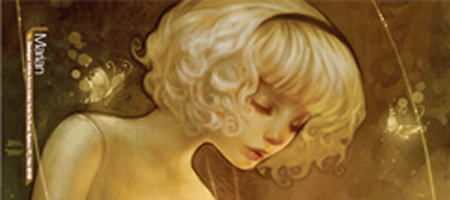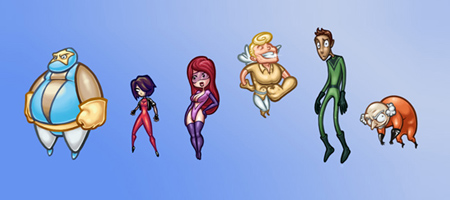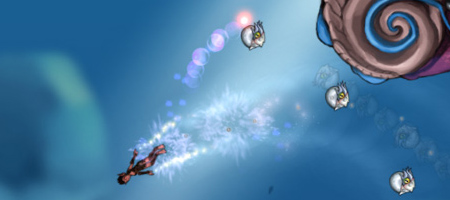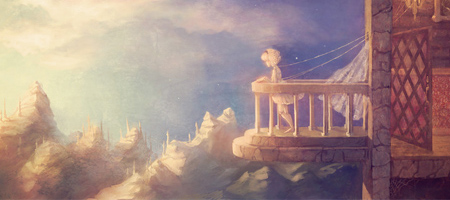GunsGunsGuns – An Interview with Infinite Ammo’s Alec Holowka

Alec Holowka is the co-developer of the Seumas McNally winning Aquaria, lead designer of the newly formed Infinite Ammo and contributor of music to various games including Crayon Physics Deluxe. He’s one of the judges for this year’s IGF awards, and so fits rather nicely into our little feature on the whole shabang. He’s currently developing Heroes and Villains for the iPhone, and then there’s the currently shrouded in intrigue and mystery Marion, a game that features a puppet with her strings cut. Interested, much? Read on to find out what we found out. Or something.
The Reticule: You won the Seumas McNally prize in 2007, and have been a judge at the IGF for the past two years. How has that position helped you when making your own games? Is it mostly extra publicity or does the variety of games you get to see each year aid in your inspiration and implementation?
Alec Holowka: The IGF is a cool event that really helps promote indie games as a whole. I’m proud to be part of the latest crop of judges. Unfortunately, I’m not always that inspired by the variety of games every year. There are a few diamonds in the rough, but 90% of the submissions are poorly made and/or based on very derivative concepts.
I’m not sure why some people pay the ~$100 entry fee submit their really poorly made games. Maybe they think its like a lottery?
TR: With the success of last year’s World of Goo, and with games like Crayon Physics Deluxe getting more attention than they perhaps would have a year or two ago, do you think indie games are about to, or already have, broken into the public consciousness?
AH: I think they are as of this year. Its very exciting! Its been growing for a long time and its nice to see some indie game creators getting a lot of attention – because they really deserve it.
I’m looking forward to see where it can go from here, but I’m also a bit worried – I hope that indie games don’t become too commercialized or boring.
TR: After writing a track for Crayon Physics (‘Afternoon Snooze’), is writing music for other people’s games something you would look to do?
AH: Yeah, I’ve also written some tracks for Kyle Pulver’s freeware games. (see Verge and Everyone Loves Active 2) I love doing it. Writing music is my favorite – and collaboration with other creative gentlemen (and ladies) is always a joy.

TR: Paper Moon, the first release of your new studio Infinite Ammo dealt with some clever 3d based puzzles, mainly involving manipulating the background of a level in some rather unorthodox ways. Similarly, Aquaria dealt with an interesting song mechanic that allowed you to affect your surroundings. Do you concern yourself with manipulating the conventions of a genre, or is it something that occurs naturally during the development process? Are there similar manipulations in Heroes and Villains and Marion?
AH: Its something that occurs very naturally. The way I start is to think about the character and the world – that’s where the inspiration comes from. What would be like to actually live as that character in that world? What things would I want to do? What things would I be able to do?
This leads to interesting things like Naija’s home – something that doesn’t necessarily add any hard game mechanics, but it deepens the experience and the atmosphere of the game significantly. It helps legitimize the world.
I like games where you can choose to perform actions that aren’t tied into progressing. It hints at how games can be a deeper experience.
I think too many game developers focus on the mechanics first, rather than focusing on the main concepts behind the world of the game. I want games to feel like entering another universe – allowing you to forget about the real world for a time. Games with mechanics that boil down to a game of rock-paper-scissors don’t do that for me.

TR: Paper Moon has been the closest step towards full 3d you’ve made so far. Do you intend to stay firmly within the 2d plane, or is a fully 3D game something you’d like to work on?
AH: I’d only really be interested in doing 3D if it served the concept of the character and game world in some interesting way.
2D is often more beautiful and more affecting than 3D ever could be. That said, 3D definitely has its powerful uses.
TR: The artwork on Heroes and Villains, and especially Marion seem to be startlingly beautiful, taking a very stylised approach. How important is artwork to the games you’re making, and have made?
AH: I tend to think of things visually first, so the artwork is very important to me. I think its one of the most immediate ways to translate ideas and emotions to the player. From there, the soundscape and the tactile feel of the gameplay flesh out the experience.

TR: While at the moment it is purely for iPhone, do you see Heroes and Villains coming to PC? If so, would it be a simple port or would you rework the game to fit the significantly larger screen?
AH: We’d like to do a high res version for PC and Mac, but we’ll have to see how the iPhone version goes first.
There is the option to expand the gameplay or just make it more pretty. I’m not sure which way we’re going to go yet, to be honest.
TR: While you’ve only released a small amount of information about Marion so far, is there anything you’d like to say about the game to give a clearer impression?
AH: Its a very personal game based around our life experiences. That makes it someone painful to work on – but that pain indicates that its a project that’s very much worth doing.
Whether I’ll survive the process of making it is another story.
TR: Thanks for your time, Alec.